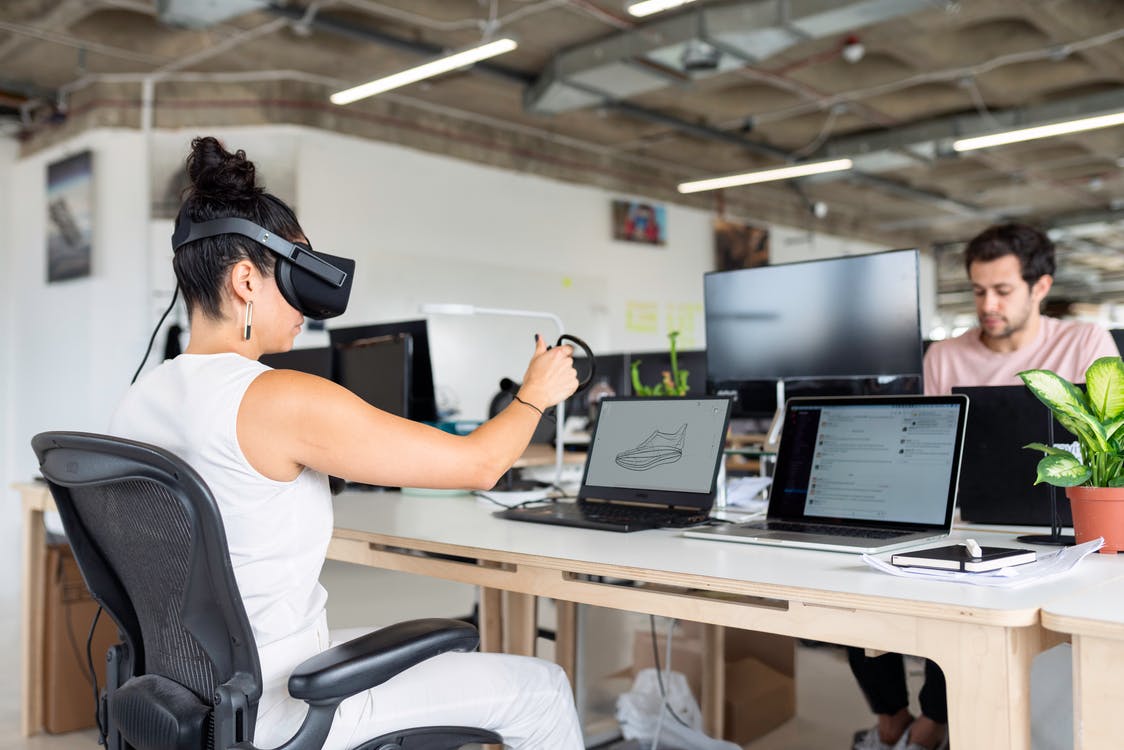You might think of virtual reality (VR) only as it is associated with the world of gaming. But this unique technology endeavor promises far outside of saving princesses. Now the question arises
What is Virtual Reality?
Virtual Reality (VR) is an immersive technology that creates a simulated environment, allowing users to interact with a digital world as if it were real. Using specialized devices like VR headsets, gloves, or controllers, individuals can explore 3D environments designed for gaming, training, education, or entertainment. Unlike traditional media, VR places users at the center of the experience, offering a sense of presence and interactivity. By combining visual, auditory, and sometimes haptic feedback, VR blurs the lines between physical and virtual realms. This cutting-edge technology continues to revolutionize industries, making it one of the most transformative innovations of the digital age.
Virtual reality (VR) refers to a computer-generated environment or reality that is designed to replicate a person’s physical presence in a specific environment that is designed to feel real. The purpose of VR is to acquiesce a person to experience and manipulate the environment as if it were the real world. The four elements of Virtual reality that separate it from other forms of technology such as mixed reality and augmented reality areas –
3D Stimulated Environment
A 3D simulated environment is a digitally created space that replicates real-world or imaginative settings in three dimensions, allowing users to explore and interact with them virtually. These environments are commonly used in virtual reality (VR), gaming, training simulations, and design applications. By integrating visual, auditory, and sometimes tactile elements, they create a lifelike experience, enhancing realism and user engagement. Industries like healthcare, education, and architecture use 3D simulations for training, visualization, and problem-solving. With advanced technologies driving innovation, 3D simulated environments are revolutionizing how we learn, design, and interact with digital spaces, bridging the gap between virtual and physical realities.
An artificial environment is rendered through a medium such as a VR display or a headset. The user’s visual mindset changes based on movements occurring in the real world.
Immersion
Immersion is the sensation of being fully absorbed or engaged in an environment, often used to describe experiences in digital or virtual settings. In technology, particularly in virtual reality (VR) and gaming, immersion refers to the user’s ability to feel as though they are part of a simulated world. This is achieved by combining elements like realistic visuals, 3D audio, and haptic feedback, which blur the lines between the virtual and physical realms. High levels of immersion can enhance learning, entertainment, and interactivity, making users lose awareness of their real-world surroundings while deeply engaging with the digital experience.
Sensory Engagement
VR includes visual, audio, and haptic cues that assist make the immersion more complete and realistic. This is where accessories or input devices such as special gloves, headsets, or hand control endeavor the VR system with additional input of movements and sensory data.
Realistic Interactivity
Realistic interactivity refers to the seamless and lifelike interactions users can have within digital or virtual environments. It focuses on creating responsive systems that mimic real-world behaviors, making the experience feel natural and intuitive. For example, in virtual reality (VR), users can manipulate objects, navigate spaces, or engage with digital elements using gestures, controllers, or haptic devices, all of which respond in real-time. This concept is crucial in applications like gaming, simulations, and training programs, where authentic interactions enhance engagement and learning. By integrating advanced technologies such as AI and physics engines, realistic interactivity transforms digital experiences into immersive and meaningful ones.
How Does VR work?
In its simplest forms, VR has experience as 3D graphics, images, or 360-degree videos on computers or smartphones running mobile apps. More complicated VR systems use wraparound computer displays or even entire rooms with high-resolution displays integrated into the walls. Increasingly, VR environments are experienced through VR headsets or goggles. These can be enthusiastic headsets such as the Oculus VR system and the HTC Vive.
How Virtual reality is revolutionizing various industries?
Virtual Reality (VR) is transforming industries by offering immersive, interactive solutions that enhance efficiency, creativity, and user experiences. In healthcare, VR is used for surgical simulations, pain management, and therapy, providing safe and controlled environments for practice and treatment. The education sector benefits from VR by creating engaging, hands-on learning experiences, such as virtual field trips and science experiments. Retail and e-commerce use VR for virtual showrooms, allowing customers to try products digitally. Real estate employs VR for virtual tours, streamlining property viewings. In entertainment and gaming, VR elevates engagement, while in manufacturing, it enhances training and prototyping, driving innovation across sectors.
Diagnostics
Virtual reality can benefit you and facilitate a better physician-patient relationship in both in-person visits and telehealth communication that happen over an internet connection. During in-person visits, doctors can more efficiently explain a diagnosis by examining X-rays and various other medical imaging engagingly directly with the patient using VR technology. By leveraging VR tech physicians can demonstrate a medical issue in an interactive, easier-to-understand manner. VR also affords more accurate and better patient medical records since they convey a more holistic picture of medical requirements and history to both patients and physicians.
High-risk job training
Firefighters, cops, and soldiers are all workers who regularly face dangerous circumstances and may asset from VR training to practice routine emergency procedures and learn the dos and don’ts in a consequence-free virtual environment. For example, a firefighter can learn emergency protocols without being in an actual burning building to test his/her knowledge. VR endeavors job trainees with ways to learn in a hands-on way outside of textbook case studies.
Cinema and entertainment
What is virtual reality? VR is changing the entertainment landscape as we know it and producers, engineers, and film studios are observing. 66% of consumers have an interest in VR for TV, movies, and videos. This shows the potential for commercial VR growth as the technology grows less expensive over time. Gaming is another area where VR is confronting expectations. VR technology acquiesces gamers to become the avatar instead of just controlling it and pushes the boundaries of the gaming medium itself.
Virtual tourism
New VR software facilitates users to visit museums and historical sites virtually. So, rather than saving up thousands to visit Greece or Morocco, you can do the next best thing: take a virtual tour. It also affords educators a unique way to scrutinize the world with their students. If you are traveling, VR also endeavors the opportunity for users to tour hotels during the booking process.
Surgeon and medical student training
As it is said earlier, VR and healthcare will be closely intertwined in the future. Another way by which VR assists health practitioners categorically relates to rare or complex surgeries. VR software means that surgeons can hone their surgical skills in a virtual simulation before achieving it on an actual patient. Likewise, medical students may asset from virtual hands-on training that presents no risk or real-life consequences.
Shopping
You might already be recognizable with the concept of virtual window shopping where you simply browse your favorite sites and favorite promising items to revisit later. VR tech is rolling out which affords even more instant gratification. VR shopping software acquiesces shoppers to window shop in a much more visceral way than just making virtual wish lists. With consumer VR, customers can virtually try on clothes, remodel their homes, and “window shop” using VR for a coherent shopping experience.
Conclusion
As you can see, what is virtual reality? And the most favored forms of VR available out there. With time, the quality of VR is getting better and better. More and more businesses are authorizing various forms of VR. Mostly virtual tours and virtual meeting rooms, to enhance their engagement with their prospects and their business module.





